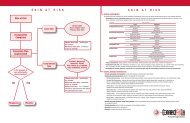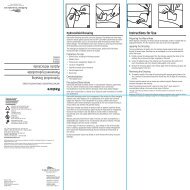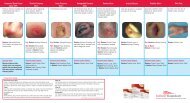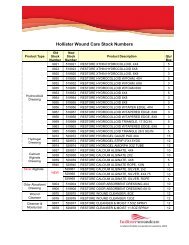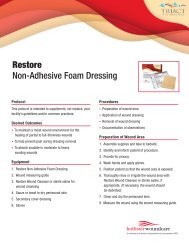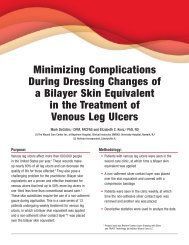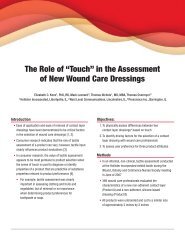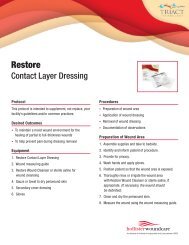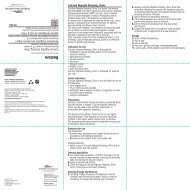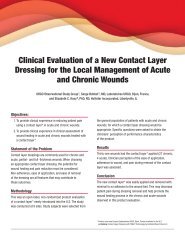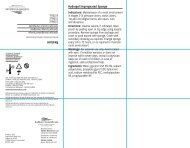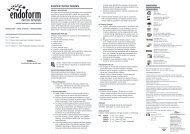Pressure 910458 B - Hollister Wound Care
Pressure 910458 B - Hollister Wound Care
Pressure 910458 B - Hollister Wound Care
Create successful ePaper yourself
Turn your PDF publications into a flip-book with our unique Google optimized e-Paper software.
P R E S S U R E U L C E R S P R E S S U R E U L C E R S<br />
<strong>Pressure</strong> Ulcer<br />
Identified<br />
Suspected<br />
Deep Tissue<br />
Injury<br />
Purple or maroon localized area of discolored<br />
intact skin or blood-filled blister due to damage<br />
of underlying soft tissue from pressure and/or<br />
shear. The area may be preceded by tissue that<br />
is painful, firm, mushy, boggy, warmer or cooler<br />
as compared to adjacent tissue.<br />
Persistent purple<br />
or maroon areas? Change in<br />
skin temperature, tissue<br />
consistency and/or sensation?<br />
Skin at risk?<br />
Cover/Protect skin: skin protectant, skin sealant, transparent film, thin hydrocolloid,<br />
thin foam, pressure relief devices<br />
Cleanse intact skin: skin cleanser<br />
Moisturize intact skin: skin moisturizer<br />
Protect intact skin: skin protectant, skin sealant, skin cleanser<br />
Cleanse wound: wound cleanser or saline<br />
Manage wound exudate:<br />
Minimal - transparent film, thin hydrocolloid, thin foam<br />
Moderate - hydrocolloid, foam, calcium alginate, collagen<br />
Heavy - calcium alginate, foam, combinations of dressings<br />
Debride wound:<br />
Dry - transparent film, hydrogel, hydrating impregnated gauze<br />
Moist/wet - hydrocolloid, foam, calcium alginate<br />
Hydrate wound: hydrogel, hydrating impregnated gauze<br />
Manage wound odor: wound cleanser, odor absorbent dressing, more frequent dressing changes,<br />
antimicrobial dressing (i.e. Silver)<br />
Assessments<br />
Completed<br />
Interventions<br />
Implemented<br />
(See reverse side for additional information)<br />
Stage I<br />
Stage II<br />
Intact skin with non-blanchable redness of a<br />
localized area usually over a bony prominence.<br />
Darkly pigmented skin may not have visible<br />
blanching; its color may differ from the<br />
surrounding area.<br />
Partial-thickness loss of dermis presenting as a<br />
shallow open ulcer with a red pink wound bed,<br />
without slough. May also present as an intact or<br />
open/ruptured serum-filled blister.<br />
Exudate?<br />
Dry wound? Odor?<br />
Periwound skin at<br />
risk or impaired?<br />
Non-blanchable redness?<br />
Changes in skin<br />
temperature, tissue<br />
consistency and/or<br />
sensation? Skin at risk?<br />
Protect intact skin: skin protectant, skin sealant, skin cleanser, transparent film,<br />
thin hydrocolloid, pressure relief devices<br />
Cleanse wound: wound cleanser or saline<br />
Manage wound exudate:<br />
Minimal - thin hydrocolloid, thin foam<br />
Moderate - foam, calcium alginate, combinations of dressings<br />
Heavy - calcium alginate, foam, combinations of dressings<br />
Debride wound:<br />
Dry - hydrogel, hydrating impregnated gauze<br />
Moist/wet - foam, calcium alginate, combinations of dressings<br />
Hydrate wound: hydrogel, hydrating impregnated gauze<br />
Manage wound odor: wound cleanser, odor absorbent dressing, more frequent dressing changes,<br />
antimicrobial dressing (i.e. Silver)<br />
Fill in dead space: calcium alginate, hydrating or impregnated gauze, foam cavity dressing<br />
Desired<br />
Outcome?<br />
NO<br />
YES<br />
Stage III<br />
Stage IV<br />
Full-thickness tissue loss. Subcutaneous fat<br />
may be visible but bone, tendon or muscle are<br />
not exposed. Slough may be present but does<br />
not obscure the depth of tissue loss. May<br />
include undermining or tunneling.<br />
Full-thickness tissue loss with exposed bone,<br />
tendon or muscle. Slough or eschar may be<br />
present on some parts of the wound bed. Often<br />
include undermining and tunneling.<br />
Exudate? Dry wound?<br />
Necrotic? Odor?<br />
Bone or muscle visible?<br />
Periwound skin at<br />
risk or impaired?<br />
Exudate? Dry wound?<br />
Necrotic? Odor?<br />
Depth or undermining?<br />
Periwound skin at<br />
risk or impaired?<br />
Monitor<br />
Reassess<br />
Unstageable<br />
<strong>Pressure</strong> Ulcer Stages as revised and copyrighted by National <strong>Pressure</strong> Ulcer Advisory Panel, Feb., 2007 *<strong>Pressure</strong> ulcer staging as per NPUAP 2007 ©<br />
Full-thickness tissue loss in which the base of<br />
the ulcer is covered by slough (yellow, tan, gray,<br />
green or brown) and/or eschar (tan, brown or<br />
black) in the wound bed.<br />
Developed in collaboration with<br />
Bonnie Sue Rolstad, RN, BA, CWOCN<br />
Bryant Rolstad Consultants, LLC, St. Paul, MN<br />
Necrotic tissue covering<br />
all or most of the wound?<br />
Periwound skin at<br />
risk or impaired?<br />
Protect intact skin: skin protectant, skin sealant, skin cleanser,<br />
transparent film, thin hydrocolloid, pressure relief devices<br />
Debride wound:<br />
Dry - transparent film, hydrogel, hydrating impregnated gauze<br />
Moist/wet - hydrocolloid, foam, calcium alginate,<br />
combination of dressings<br />
Manage wound odor: wound cleanser, odor absorbent dressing,<br />
more frequent dressing changes, antimicrobial dressing<br />
(i.e. Silver)
Suspected DTI<br />
Suspected Deep Tissue Injury:<br />
Purple or maroon localized area of<br />
discolored intact skin or blood-filled<br />
blister due to damage of underlying soft<br />
tissue from pressure and/or shear. The<br />
area may be preceded by tissue that is<br />
painful, firm, mushy, boggy, warmer or<br />
cooler as compared to adjacent tissue.<br />
Deep tissue injury may be difficult to<br />
detect in individuals with dark skin<br />
tones. Evolution may include a thin blister<br />
over a dark wound bed. The wound<br />
may further evolve and become covered<br />
by thin eschar. Evolution may be rapid<br />
exposing additional layers of tissue even<br />
with optimal treatment.<br />
Goals of <strong>Care</strong>: limit or avoid tissue<br />
injury by pressure offloading.<br />
<strong>Wound</strong> and Skin <strong>Care</strong> Objectives:<br />
Protect periwound skin and assess<br />
frequently.<br />
A Stage III pressure ulcer involves<br />
subcutaneous tissue that may extend<br />
down to, but not through, underlying<br />
fascia. It may present as a deep crater<br />
with or without undermining of tissue.<br />
Yellow slough or necrotic tissue may<br />
be present.<br />
Goals of <strong>Care</strong>: restore skin integrity and<br />
avoid infection. Relieve <strong>Pressure</strong>.<br />
<strong>Wound</strong> and Skin <strong>Care</strong> Objectives:<br />
protect intact periwound skin, cleanse<br />
wound, manage wound exudate, debride<br />
wound, hydrate wound, manage wound<br />
odor, and fill in dead space.<br />
Stage I<br />
A Stage I pressure ulcer is an observable<br />
pressure related alteration of intact<br />
skin whose indicators, as compared to<br />
an adjacent or opposite area on the<br />
body, may include changes in one or<br />
more of the following: skin temperature<br />
(warmth or coolness), tissue consistency<br />
(firm or boggy feel), and/or sensation<br />
(pain, itching). In lightly pigmented skin<br />
the ulcer appears as a defined area of<br />
persistent non-blanchable redness. In<br />
darker skin tones, the ulcer may vary<br />
in color from the surrounding area.<br />
Goals of <strong>Care</strong>: maintain intact skin<br />
and improve tissue tolerance.<br />
Relieve pressure.<br />
<strong>Wound</strong> and Skin <strong>Care</strong> Objectives:<br />
protect, cleanse and moisturize<br />
intact skin.<br />
A Stage IV pressure ulcer involves<br />
muscle, bone or supporting structures.<br />
Undermining or sinus tracts may also<br />
be present.<br />
Goals of <strong>Care</strong>: restore skin integrity and<br />
avoid infection. Relieve pressure.<br />
<strong>Wound</strong> and Skin <strong>Care</strong> Objectives:<br />
protect intact periwound skin, cleanse<br />
wound, manage wound exudate, debride<br />
wound, hydrate wound, manage wound<br />
odor, and fill in dead space.<br />
Stage II<br />
Stage III Stage IV Unstageable<br />
A Stage II pressure ulcer involves<br />
the epidermis, dermis or both. It<br />
is a superficial wound and may<br />
present as an abrasion, blister or shallow<br />
crater. Yellow slough and necrotic tissue<br />
are never present.<br />
Goals of <strong>Care</strong>: restore skin integrity and<br />
avoid infection. Relieve pressure.<br />
<strong>Wound</strong> and Skin <strong>Care</strong> Objectives:<br />
protect intact periwound skin, cleanse<br />
wound, manage wound<br />
exudate, debride wound, hydrate wound,<br />
and manage wound odor.<br />
An Unstageable pressure ulcer is<br />
covered with eschar or slough which<br />
prohibits assessment of wound depth.<br />
Goals of <strong>Care</strong>: protect viable tissue,<br />
remove necrotic tissue so that wound<br />
assessment and staging may be<br />
accomplished. Relieve pressure<br />
<strong>Wound</strong> and Skin <strong>Care</strong> Objectives:<br />
protect intact periwound skin, debride<br />
wound and manage wound odor.<br />
NOTE: Stable (dry, adherent, intact without<br />
erythema or fluctuance) eschar on heels<br />
serves as the "body's natural cover".<br />
These heel ulcers may be left intact with<br />
pressure relief provided.<br />
P R E S S U R E<br />
BACKGROUND INFORMATION:<br />
U L C E R S<br />
A pressure ulcer a localized injury to the skin and/or underlying tissue usually over a bony prominence, as a result of pressure,<br />
or pressure in combination with shear and/or friction. When pressure is not relieved, tissue ischemia develops and a pressure<br />
ulcer results. Most pressure ulcers are preventable. Therefore, early risk assessment, skin care, pressure offloading, attention<br />
to patient support surfaces and education are essential.<br />
Standard practice is to assess and stage pressure ulcers according to the National <strong>Pressure</strong> Ulcer Advisory Panel's staging<br />
system. Once a pressure ulcer is staged, the healing wound is not restaged. Therefore, a healing stage III pressure ulcer does<br />
not become a stage II. It remains, according to the original diagnosis, a stage III pressure ulcer which is healing. The depth of<br />
the wound is only one of many factors which requires evaluation.<br />
The algorithm on the reverse side provides a general path of decision-making for the assessment, management and<br />
treatment of pressure ulcers. Below is more detailed information which is intended to assist health care providers. This should<br />
be used along with the consultative services of a wound care specialist, WOC/ET nurse, physical therapist, clinical nurse<br />
specialist with expertise in wound management or a physician when indicated.<br />
NURSING ASSESSMENTS:<br />
The following provides a guideline for clinical assessment. Assessments are done at regular intervals and are used<br />
to drive treatment decisions.<br />
• Assessment of risk or contributing factors: decreased sensory perception; moisture; immobility; poor nutrition;<br />
friction/shear. Tools such as the Braden Scale are helpful in determining patient risk.<br />
• Assessment of nutrition, pain, previous ulcer care (if applicable), level of understanding,<br />
compliance in care, and learning style.<br />
• Assessment of wound: location; stage; infection; exudate; odor; size (length, width and depth); necrotic tissue;<br />
granulation; epithelialization; undermining and/or tunneling.<br />
• Assessment of periwound skin: fragile; dry; macerated; indurated; erythematous.<br />
GENERAL NURSING INTERVENTIONS:<br />
The following information is designed as a guideline for care. Consult with a wound care specialist and/or physician with<br />
questions and when managing full-thickness and infected wounds.<br />
• Minimize or eliminate the cause of the problem: <strong>Pressure</strong> offloading involves proper turning; transferring and<br />
positioning techniques; support surfaces for bed or chair as indicated by level of risk and/or severity of the wound.<br />
With heel/foot ulcers, provide appropriate pressure relief and orthotics as needed.<br />
• Support moist wound healing.<br />
• Treat infection: Provide debridement, cleansing and antimicrobial dressing.<br />
• Debride: this is based upon condition of the wound and the patient. Methods of debridement include autolytic,<br />
mechanical, sharp and enzymatic.<br />
• Protect the wound from external contamination (e.g., fecal matter, urine, microorganisms) and trauma.<br />
• Perform daily skin inspection and care: this may include cleansing, moisturizing and the use of protective barriers.<br />
• Provide adequate nutritional intake.<br />
• Manage pain.<br />
• Provide education: patient, family and caregiver.<br />
• Document assessments and interventions.<br />
• Reassess at regular intervals per facility protocol.<br />
H O L L I S T E R W O U N D C A R E P R O D U C T S<br />
Suspected DTI/Stage I Stage II/Stage III Stage IV<br />
PERIWOUND SKIN CARE<br />
Restore Cleanser & Moisturizer<br />
Restore Skin Cleanser<br />
Restore DimethiCreme<br />
Restore Moisture Barrier<br />
Restore Skin Conditioning Cream<br />
WOUND CARE<br />
Restore Extra Thin Hydrocolloid Dressing<br />
(to prevent friction injury)<br />
Unstageable<br />
PERIWOUND SKIN CARE<br />
Restore Cleanser & Moisturizer<br />
Restore Skin Cleanser<br />
Restore DimethiCreme<br />
Restore Moisture Barrier<br />
Restore Skin Conditioning Cream<br />
WOUND CARE<br />
Restore <strong>Wound</strong> Cleanser<br />
Restore Extra Thin Hydrocolloid Dressing<br />
Restore Hydrocolloid Dressing<br />
Restore Hydrogel Dressing<br />
Restore Calcium Alginate Dressing<br />
with/without silver<br />
Restore Contact Layer with/without Silver<br />
Restore Foam Dressing with/without Silver<br />
Restore Odor-Absorbent Dressing<br />
for improved outcomes<br />
PERIWOUND SKIN CARE<br />
Restore Cleanser & Moisturizer<br />
Restore Skin Cleanser<br />
Restore DimethiCreme<br />
Restore Moisture Barrier<br />
Restore Skin Conditioning Cream<br />
WOUND CARE<br />
Restore <strong>Wound</strong> Cleanser<br />
Restore Extra Thin Hydrocolloid Dressing<br />
Restore Hydrocolloid Dressing<br />
Restore Hydrogel Dressing<br />
Restore Calcium Alginate Dressing<br />
with/without Silver<br />
Restore Contact Layer Dressing<br />
with/without Silver<br />
Restore Foam Dressing with/without Silver<br />
Restore Odor-Absorbent Dressing<br />
REFERENCES<br />
Bergstrom N, Bennett MA, Carlson CE, et al. Treatment of <strong>Pressure</strong> Ulcers.<br />
Clinical Practice Guideline, No.15. Rockville, MD: U.S. Department of Health<br />
and Human Services. Public Health Service, Agency for Health <strong>Care</strong> Policy<br />
and Research. AHCPR Publication No. 95-0652. December 1994.<br />
Hess, Cathy Thomas. Nurse's Clinical Guide to <strong>Wound</strong> <strong>Care</strong>.<br />
Springhouse, PA: Springhouse Corporation, 1997.<br />
Krasner D, Kane D (eds). Chronic <strong>Wound</strong> <strong>Care</strong>: A Clinical Source Book<br />
for Healthcare Professionals, Second Edition, Wayne, Pennsylvania:<br />
Health Management Publications, Inc. 1997.<br />
Maklebust J. Using wound care products to promote a healing<br />
environment. Critical <strong>Care</strong> Nursing Clinics of North America 1996<br />
8(2) 141-158.<br />
Maklebust J, Sieggreen. <strong>Pressure</strong> Ulcers: Guidelines for Prevention<br />
and Nursing Management. Second Edition. Springhouse, PA:<br />
Springhouse Corporation, 1996.<br />
Panel for the Prediction and Prevention of <strong>Pressure</strong> Ulcers in Adults.<br />
<strong>Pressure</strong> Ulcers in Adults: Prediction and Prevention. Clinical Practice<br />
Guideline, No. 3. AHCPR Publication No. 92-0047. Rockville, MD: Agency<br />
for Health <strong>Care</strong> Policy and Research, Public Health Service,<br />
U.S. Department of Health and Human Services, May 1992.<br />
Rolstad BS. <strong>Wound</strong> dressings: Making the right match.<br />
Nursing 97 June 32hn1-3.<br />
<strong>Wound</strong>, Ostomy and Continence Nurses Society: Standards of <strong>Care</strong>,<br />
Patient with Dermal <strong>Wound</strong>: <strong>Pressure</strong> Ulcers. Laguna Beach, CA 1992.<br />
PERIWOUND SKIN CARE<br />
Restore Cleanser & Moisturizer<br />
Restore Skin Cleanser<br />
Restore DimethiCreme<br />
Restore Moisture Barrier<br />
Restore Skin Conditioning Cream<br />
WOUND CARE<br />
Restore <strong>Wound</strong> Cleanser<br />
Restore Hydrogel Dressing<br />
Restore Calcium Alginate Dressing<br />
with/without Silver<br />
Restore Contact Layer Dressing<br />
with/without Silver<br />
Restore Foam Dressing with/without Silver<br />
Restore Odor-Absorbent Dressing<br />
<strong>Hollister</strong> <strong>Wound</strong> <strong>Care</strong> LLC<br />
1580 South Milwaukee Avenue<br />
Suite 405<br />
Libertyville, IL 60048<br />
1.888.740.8999<br />
Distributed in Canada by<br />
<strong>Hollister</strong> Limited<br />
95 Mary Street<br />
Aurora, Ontario L4G 1G3<br />
1.800.263.7400<br />
©2009 <strong>Hollister</strong> <strong>Wound</strong> <strong>Care</strong> LLC.<br />
<strong>Hollister</strong>woundcare and wave logo are<br />
trademarks of <strong>Hollister</strong>, Inc. Restore is a<br />
trademark of <strong>Hollister</strong> <strong>Wound</strong> <strong>Care</strong> LLC.<br />
Connect-Ed is a service mark of <strong>Hollister</strong><br />
<strong>Wound</strong> <strong>Care</strong> LLC.<br />
<strong>910458</strong>-209



